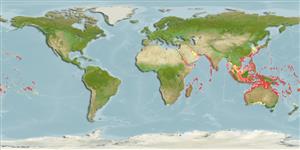Environment: milieu / climate zone / depth range / distribution range
Ecología
marino asociado a arrecife; no migratorio; rango de profundidad 0 - 60 m (Ref. 89972). Tropical; 30°N - 20°S
Indo-Pacific: Red Sea and East Africa (extending to Mossel Bay, South Africa, Ref. 5372) to the Hawaiian, Marquesan, and Ducie islands, north to southern Japan, south to Lord Howe and Rapa islands.
Length at first maturity / Tamaño / Peso / Age
Maturity: Lm 13.0 range ? - ? cm
Max length : 25.0 cm TL macho / no sexado; (Ref. 129178)
Espinas dorsales (total) : 12 - 13; Radios blandos dorsales (total) : 22 - 25; Espinas anales: 3; Radios blandos anales: 19 - 21.
May be seen in a variety of habitats ranging from rich coral reefs (Ref. 58652) to weedy and rubble covered areas (Ref. 1602). Benthopelagic (Ref. 58302). Maybe found singly, in pairs, and in aggregations that roam over large distances in search of food. Feed mainly by tearing pieces from polychaetes, sea anemones, coral polyps, and algae (Ref. 1602). Oviparous (Ref. 205). Form pairs during breeding (Ref. 205). Minimum depth reported taken from Ref. 128797.
Life cycle and mating behavior
Madurez | Reproducción | Puesta | Huevos | Fecundidad | Larva
Distinct pairing (Ref. 205). Monogamous mating is observed as both obligate and social (Ref. 52884).
Allen, G.R., 1985. Butterfly and angelfishes of the world. Vol. 2. 3rd edit. in English. Mergus Publishers, Melle, Germany. (Ref. 4858)
IUCN Red List Status (Ref. 130435: Version 2024-1)
Threat to humans
Reports of ciguatera poisoning (Ref. 130160)
Human uses
Pesquerías: escaso valor comercial; Acuario: Comercial
Herramientas
Special reports
Download XML
Fuentes de Internet
Estimates based on models
Preferred temperature (Ref.
123201): 25.5 - 29, mean 28 °C (based on 922 cells).
Phylogenetic diversity index (Ref.
82804): PD
50 = 0.5000 [Uniqueness, from 0.5 = low to 2.0 = high].
Bayesian length-weight: a=0.02570 (0.01667 - 0.03962), b=2.98 (2.85 - 3.11), in cm total length, based on LWR estimates for this species & Genus-body shape (Ref.
93245).
Nivel trófico (Ref.
69278): 3.7 ±0.3 se; based on diet studies.
Resiliencia (Ref.
120179): Alto, población duplicada en un tiempo mínimo inferior a 15 meses (K = 1.5;).
Fishing Vulnerability (Ref.
59153): Low vulnerability (23 of 100).
Nutrients (Ref.
124155): Calcium = 93.2 [46.4, 155.6] mg/100g; Iron = 0.905 [0.498, 1.574] mg/100g; Protein = 19 [18, 20] %; Omega3 = 0.126 [0.071, 0.224] g/100g; Selenium = 46.9 [24.0, 94.1] μg/100g; VitaminA = 30 [8, 113] μg/100g; Zinc = 1.26 [0.82, 1.89] mg/100g (wet weight);
